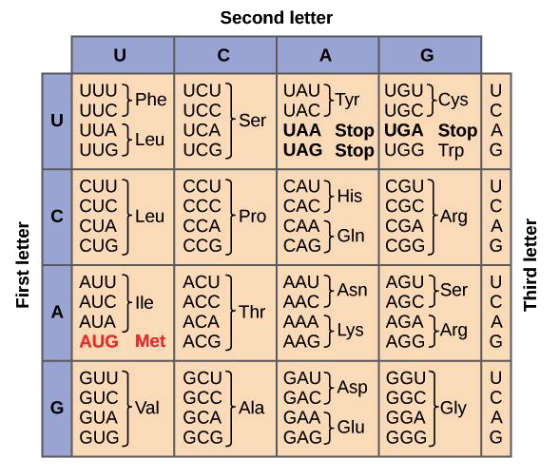
Biology - DNA & RNA
DNA
DNA stands for Deoxyribonucleic Acid. It is has the shape of a double helix.
It is established by James Watson and Francis Crick.
These are codes for your genes (traits) and they are made of repeating subunits called nucelotides.
Nucleotide – It has three parts: Phosphate Deoxyribose (sugar), base (A, T, G, C)
Base-Pair Rule
Adenine –Thymine
Guanine –Cytosine
A T A, T C A, T G C, G G G
The sides of the DNA ladder are phosphate and sugar and they are held together by hydrogen bonds.
How does the Code work?
The combination of A, T, G, C determines what traits you might have:
C A T C A T = purple hair
T A C T A C = yellow hair
DNA Replication
The process by which DNA makes a copy of itself (cell division)
Semi-Conservative – Half of the old strand is saved.
RNA
It is called the messenger. It only has a single strand, has ribose sugar. It contains no thymine, but uracil instead. It can leave the nucleus and follows
Transcription–Process where RNA is made from DNA, occurs in the nucleus of the cell.
Translation–Process where proteins are made from RNA, occurs in the cytoplasm.

Biology - DNA & RNA
DNA
DNA stands for Deoxyribonucleic Acid. It is has the shape of a double helix.
It is established by James Watson and Francis Crick.
These are codes for your genes (traits) and they are made of repeating subunits called nucelotides.
Nucleotide – It has three parts: Phosphate Deoxyribose (sugar), base (A, T, G, C)
Base-Pair Rule
Adenine –Thymine
Guanine –Cytosine
A T A, T C A, T G C, G G G
The sides of the DNA ladder are phosphate and sugar and they are held together by hydrogen bonds.
How does the Code work?
The combination of A, T, G, C determines what traits you might have:
C A T C A T = purple hair
T A C T A C = yellow hair
DNA Replication
The process by which DNA makes a copy of itself (cell division)
Semi-Conservative – Half of the old strand is saved.
RNA
It is called the messenger. It only has a single strand, has ribose sugar. It contains no thymine, but uracil instead. It can leave the nucleus and follows
Transcription–Process where RNA is made from DNA, occurs in the nucleus of the cell.
Translation–Process where proteins are made from RNA, occurs in the cytoplasm.

 Knowt
Knowt